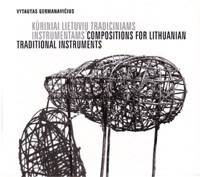Nature, imagination and poetry – these are what inspire
Vytautas Germanavičius' music. The melodies of his compositions shimmer like rain drops and trickle in thin rivulets across the window pane, while the harmonies bloom amongst tree branches from which white petals fall. His music invokes images of spring, summer and fall, but never is there a cold winter ray or frozen elegance. All the images are alive, lush, fragrant, and ringing. At times the musical phrases flow freely, at times they unexpectedly repeat. These unexpected reminiscences strongly impact the listener renewing and returning those already-experienced impressions. While listening to the music, moments flash like embers and the fragments of a time long past slink by like shadows.
Such compositions of Vytautas Germanavičius that reveal the beauty of diminutive forms were written for traditional Lithuanian instruments, even though the composer is not especially linked with this tradition. Like all the other artists of the 21st century, he is open to influences of various cultures of the world. In his imagination, new impressions exist alongside familiar things – the "new" is just as valuable as the "old." Contemporary artistic images as well as symbols of the past are necessary for the composer to address the universal issues, which are at times more important than the music itself.
Traditional Lithuanian instruments are linked to various beliefs. In the past it was believed that a zither-like string instrument, the kanklės, had to be made when a loved one dies. To do so, one must go to the forest and listen to which tree rings as it sways. The kanklės made from this tree will speak with the voice of the deceased father or mother. A wind instrument birbynė was made before the shepherds' holiday – Sekminės. On the morning of the holiday the shepherds tried to drive their animals to pasture as early as possible and there they warbled on their reed-pipes. Whichever shepherd blew his birbynė first would have luck for the whole year. These beliefs are very important for a person versed in traditional culture since they give the sounds of the ancient instruments a deeper meaning. However, without seeking these cultural depths, one can also listen to the music of the kanklės and birbynė as a contemporary expression.
The magic of the sound is most strongly felt in the composition written for three birbynės of different pitches and lamzdelis, titled "Dance of the Cranes" and performed by a birbynė virtuoso Irmantas Andriūnas. The performer imitates the sounds of honking cranes, thereby himself becoming a bird, which reminds one of an ancient hunter mimicking the totem. This ritual is not for its own sake. The imitation of the sounds of nature becomes an unusual and unexpected tonal search, a creative breakthrough, a renewal of tradition. The birbynė rings as it has never rung before. A completely new perspective of how to play the instrument is revealed.
In Vytautas Germanavičius' compositions, the sounds of traditional instruments resound not only above Lithuanian forests and fields but also wind their way over mountains and skyscrapers. Principle components of the visual arts are indisputably important to the composer. He is a traveller, an observer, and thus some of his creations can be understood as diaries of a trip or as landscapes preserved by a photographic memory. Examples of such works on this CD include "California Sketches" and "Ringing Mountaintops" written for kanklės and two birbynė. In both pieces there is a movement of lines, a shifting of colours and moods, as if landscapes of various rhythms were flying past the eyes of the traveller, while he is swept away by various states of being.
The Eastern aesthetic is especially important to the composer. His music reflects the beauty of the seasons, the hardly perceptible changes in nature and the subtle vibrations of the soul. The piece "Snowing Magnolia Blossoms" written for kanklės conjures a miracle of spring: falling petals of different shades of white and red. In this composition, the Lithuanian kanklės sound like the traditional Japanese instrument, the koto. The talented musician Aistė Bružaitė also presents new and innovative tonal possibilities for the kanklės.
In the past, the composer has chosen Japanese haikus as lyrics for his pieces, but this time he chose fragments of Vyt Bakaitis' poems. In these texts the relationships between words are marked by dots, and one has to guess the meaning as if solving a riddle. The music tries to reveal the meanings and double meanings of words. In the piece with words written by poetess Marie Étienne, one plunges into emotional depths in an effort to evoke the dramatization of painful experiences.
The sounds of traditional instruments are accompanied by not only a soft soprano, but also by accordion, piano, and violin. The combination of traditional and classical instruments in Vytautas Germanavičius' music is not contradictory. The sounds of the instruments do not symbolize the traditional and the modern, or a clash of other opposing worldviews. All of the instruments subtly compliment each other, even blend together like watercolours in the piece "Falling Raindrops" for the trio of violin, piano and contrabass birbynė.
In this album the composer strives to express the wholeness of inner life. Excitement and worry suddenly disrupt the mood of peacefulness in his music, while emotional openness is reached only by speaking in hints and suggestions.
Austė Nakienė

